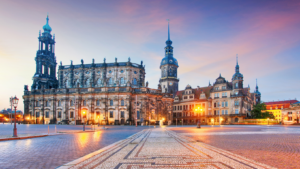Europe’s allure often lies in its world-renowned capitals. Yet, beyond the hustle and bustle of these well-trodden paths, there’s a treasure trove of hidden gems waiting to be discovered. This article will take you on a journey off the beaten track, revealing some of Europe’s best-kept secrets.
From quaint villages untouched by time to vibrant cities pulsating with modern culture, Europe’s lesser-known destinations offer a different kind of charm. They’re places where you can escape the crowds and experience the authentic, the unique, and the extraordinary.
So, pack your sense of adventure and prepare to uncover the hidden gems of Europe. This is your ticket to a journey of discovery, where every turn can reveal a new, unexpected delight. Stay tuned, and let’s explore the road less traveled together.
Hidden Gems in Europe
 Resting behind Europe’s fame are extraordinary destinations; silent yet exuding a unique charm, drawing curious travelers to their bewitching landscapes. Let’s unveil the veil on these hidden gems in Europe, dive deep into their characteristics and understand why these treasures of Europe continue to bedazzle their visitors.
Resting behind Europe’s fame are extraordinary destinations; silent yet exuding a unique charm, drawing curious travelers to their bewitching landscapes. Let’s unveil the veil on these hidden gems in Europe, dive deep into their characteristics and understand why these treasures of Europe continue to bedazzle their visitors.
Europe’s charm goes beyond the popular attractions, spilling over into corners yet to be explored by the average tourist. Numerous less-mentioned sites too are sure to captivate travel enthusiasts with their aesthetic allure and natural beauty. Just as discovering these hidden places often requires expert guidance, students seeking support in academic writing can turn to a ghostwriter, who helps bring clarity and structure to complex topics.
Diverse Architectural Hidden Gems
European architecture, known for its diversity, encompasses styles ranging from Romanesque to Modernist. Each country, each city, boasts a unique blend reflective of its rich history and cultural influences. For instance, the quiet Albanian town of Gjirokastër, cited by UNESCO for its distinctive Ottoman architecture, has myriad stone houses huddled on a hill, providing a picturesque view. A trip to Portugal’s Coimbra reveals an exceptional architectural gem: Portugal’s oldest university, featuring a blend of styles from Gothic to Baroque.
Natural Wonders: Europe’s Unexplored Beauty
 Equally bewitching are Europe’s underappreciated natural wonders. Mountains, forests, and lakes adorn the continent in a myriad of hues and textures, providing a lifetime’s worth of exploration opportunities. Moldova’s Orheiul Vechi flaunts dramatic cliffscapes that command attention, while Denmark’s Rabjerg Mile, a migrating coastal dune, offers a terrain so rare, it’s a spectacle in its own right. On the Isle of Skye in Scotland, the Elgol Peninsula provides a panoramic view of the towering Cuillin Mountains across the sea, a sight for every nature lover’s bucket list. Europe’s unexplored beauty, notwithstanding its scale, never fails to dazzle the eager explorer.
Equally bewitching are Europe’s underappreciated natural wonders. Mountains, forests, and lakes adorn the continent in a myriad of hues and textures, providing a lifetime’s worth of exploration opportunities. Moldova’s Orheiul Vechi flaunts dramatic cliffscapes that command attention, while Denmark’s Rabjerg Mile, a migrating coastal dune, offers a terrain so rare, it’s a spectacle in its own right. On the Isle of Skye in Scotland, the Elgol Peninsula provides a panoramic view of the towering Cuillin Mountains across the sea, a sight for every nature lover’s bucket list. Europe’s unexplored beauty, notwithstanding its scale, never fails to dazzle the eager explorer.
Cultural Insights into Europe’s Hidden Gems
Beyond the flavors of cuisines and spirits, hidden gems in Europe lure visitors into their unique traditions, rituals, and history. The following subsections delve deeper into these facets, providing valuable insights into their cultural significance.
Encountering Unique Traditions and Festivals
 Europe’s concealed treasures shine the most during their local festivals and traditions. For instance, Spain’s La Tomatina, a tomato-throwing festival in Buñol, paints a vibrant picture of traditional European festivities. Likewise, Germany’s Oktoberfest presents a grand spectacle of beer culture, attracting admiring crowds from all over the world. These events are not just about enjoyment—they serve as mediums to observe and assimilate the timeless culture of these regions, something not found in your regular city guidebook.
Europe’s concealed treasures shine the most during their local festivals and traditions. For instance, Spain’s La Tomatina, a tomato-throwing festival in Buñol, paints a vibrant picture of traditional European festivities. Likewise, Germany’s Oktoberfest presents a grand spectacle of beer culture, attracting admiring crowds from all over the world. These events are not just about enjoyment—they serve as mediums to observe and assimilate the timeless culture of these regions, something not found in your regular city guidebook.
History has a profound and enduring influence on hidden gems in Europe. One sees this reflected in locations like the city of Matera, Italy. Once considered a national disgrace due to its extreme poverty, Matera is now renowned for its historical Sassi districts. Similarly, the cobblestone streets of the Faroe Islands whisper stories of Viking explorers. Such historical imprints not only enhance the aesthetic appeal of these gems but also enrich the cultural learning for curious visitors, tying them closer to Europe’s vibrant past.

